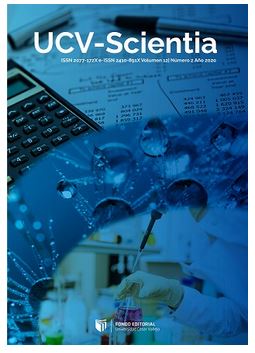Tecnologías inteligentes: Innovación para un sistema legal eficiente
DOI:
https://doi.org/10.18050/revucv-scientia.v16n1a7Palabras clave:
tecnologías legales, inteligencia artificial, sistema legalResumen
La temática referida a tecnologías inteligentes como mecanismo de innovación para un sistema legal eficiente ha cobrado relevante importancia en los últimos años, particularmente, a raíz de la propagación del COVID-19, lo que aceleró la interacción digital entre los actores usuarios del sistema legal, encontrándose a partir de dicha fecha importante información investigativa al respecto, principalmente en los países más desarrollados del planeta, tales como China y Estados Unidos, de ahí que el propósito de esta investigación es examinar el impacto y las repercusiones de las tecnologías inteligentes en la eficiencia del sistema legal, considerando estudios realizados en los últimos seis años. Se analizaron 40 confiables artículos, todos referidos al tema objeto de revisión; se destaca la teoría de Masbernat & Pasquino (2023) en el sentido que nos encontramos frente a un cambio de paradigma; así como los estudios de Papagianneas & Junius (2023) y Shi et al. (2021). Se analizó pormenorizadamente la literatura utilizando artículos de Scopus, Web of Science, EBSCO, vLex, ScienceDirect, en el intervalo de tiempo que abarca desde el año 2018 hasta noviembre de 2023, para analizar la producción científica en relación a tecnologías legales inteligentes.
Referencias
Agudo, U., Liberal, K. G., Arrese, M., & Matute, H. (2024). The impact of AI errors in a human-in-the-loop process. Cognitive Research: Principles and Implications, 9(1), 1–16. https://doi.org/10.1186/s41235-023-00529-3
Barnett, J., & Treleaven, P. (2018). Algorithmic Dispute Resolution-The Automation of Professional Dispute Resolution Using AI and Blockchain Technologies. Computer Journal, 61(3), 399–408. https://doi.org/10.1093/comjnl/bxx103
Barysė, D. (2022). People’s Attitudes towards Technologies in Courts. Laws, 11(5), 1-28. https://doi.org/10.3390/laws11050071
Barysė, D., & Sarel, R. (2024). Algorithms in the court: does it matter which part of the judicial decision-making is automated? Artificial Intelligence and Law, 32(1), 117–146. https://doi.org/10.1007/s10506-022-09343-6
Chaudhary, G. (2024). Explainable Artificial Intelligence (xAI): Reflections on Judicial System. Kutafin Law Review, 10(4), 872–889. https://doi.org/10.17803/2713-0533.2023.4.26.872-889
Corvalán, J. G. (2018). Inteligencia artificial: Retos, desafíos y oportunidades - Prometea: La primera inteligencia artificial de Latinoamérica al servicio de la Justicia. In Revista de Investigacoes Constitucionais. 5(1), 295–316. https://doi.org/10.5380/rinc.v5i1.55334
Daño, N., & Prato, S. (2019). Editorial: The Real Technology Revolution: Technology Justice. In Development (Basingstoke. Palgrave Macmillan. 62(1), 1–4. https://doi.org/10.1057/s41301-019-00230-3
De of City, E. (2019). Janus-Faced Justice? The Role of Legal Technology in the Provision of Access to Justice. Legal Information Management, 19(01), 63–65. https://doi.org/10.1017/s1472669619000148
De Oliveira Vidal, E. I., & Fukushima, F. B. (2021). The art and science of writing a scientific review article. In Cadernos de Saude Publica. 37(4), 1-4. https://doi.org/10.1590/0102-311X00063121
Fine, A., & Marsh, S. (2024). Judicial leadership matters (yet again): the association between
judge and public trust for artificial intelligence in courts. Discover Artificial Intelligence, 4(1), 1–18. https://doi.org/10.1007/s44163-024-00142-3
Gómez-Diago, G. (2022). Typologies of paradigms in communication research. A classification proposal. Revista de Comunicacion, 81(1), 181–194. https://doi.org/10.26441/RC21.1-2022-A9
Gowder, P. (2018). Transformative legal technology and the rule of law. In University of Toronto Law Journal. 68, 82–105. https://doi.org/10.3138/utlj.2017-0047
Guirao-Goris, S. J. A., Ferrer Ferrandiz, E., Enfermeria, E., & Fe, L. (2008). The revision article http://revista.enfermeriacomunitaria.org/articuloCompleto.php?ID=7.
Hagan, M. (2019). Participatory design for innovation in access to justice. Daedalus, 148(1), 120–127. https://doi.org/10.1162/DAED_a_00544
Heath, K. (2019). Digital Justice: Technology and the Internet of Disputes. IEEE Transactions on Professional Communication, 62(4), 398–399. https://doi.org/10.1109/TPC.2019.2947000
Leng, C., Tang, Z., Zhou, Y. G., Tian, Z., Huang, W. Q., Liu, J., Li, K., & Li, K. (2023). Fifth Paradigm in Science: A Case Study of an Intelligence-Driven Material Design. Engineering, 24, 126–137. https://doi.org/10.1016/j.eng.2022.06.027
Lopes, G. (2024). Artificial intelligence and judicial decision-making: Evaluating the role of AI in debiasing. Journal for Technology Assessment in Theory and Practice, 33(1), 28–33. https://doi.org/10.14512/tatup.33.1.28
Ma, W. (2022). Artificial Intelligence-Assisted Decision-Making Method for Legal Judgment Based on Deep Neural Network. Mobile Information Systems, 2022, 1–9. https://doi.org/10.1155/2022/4636485
Mania, K. (2022). The Digital Transformation of Legal Industry: Management Challenges and Technological Opportunities. Danube, 13(3), 209–225. https://doi.org/10.2478/danb-2022-0013
Mania, K. (2023). Legal Technology: Assessment of the Legal Tech Industry’s Potential. Journal of the Knowledge Economy, 14(2), 595–619. https://doi.org/10.1007/s13132-022-00924-z
Mareschal, B., Kaur, M., Kharat, V., & Sakhare, S. (2021). Convergence of Smart Technologies for Digital Transformation. In Tehnicki Glasnik. 15(1), 1-9. https://doi.org/10.31803/tg-20210225102651
Masbernat, P., & Pasquino, V. (2023. Artificial Intelligence and its problematic impact on the Law. Revista de Educacion y Derecho, 28. https://doi.org/10.1344/REYD2023.28.43934
Münch, L. A. C., & Ferraz, T. S. (2024). Exploring Defuturing to Design Artificial-Intelligence Artifacts: A Systemic-Design Approach to Tackle Litigiousness in the Brazilian Judiciary. Laws, 13(1), 1–13. https://doi.org/10.3390/laws13010004
Papagianneas, S., & Junius, N. (2023). Fairness and justice through automation in China’s smart courts. Computer Law and Security Review, 51, 1-13. https://doi.org/10.1016/j.clsr.2023.105897
Pashentsev, D. A. (2020). Features of law enforcement in the conditions of digitalization of social relations. Vestnik Sankt-Peterburgskogo Universiteta. Pravo, 11(1), 35–49. https://doi.org/10.21638/spbu14.2020.103
Rehder, B., Apitzsch, B., & Vogel, B. (2021). Legal Technology im Arbeitsrecht. Arbeit, 30(4), 357–374. https://doi.org/10.1515/arbeit-2021-0023
Reiling, D., & Contini, F. (2022). E-Justice Platforms: Challenges for Judicial Governance. International Journal for Court Administration, 13(1), 1-20. https://doi.org/10.36745/ijca.399
Rostain, T. (2019). Techno-optimism & access to the legal system. Daedalus, 148(1), 93–97. https://doi.org/10.1162/DAED_a_00540
Rowden, E., & Wallace, A. (2018). Remote judging: The impact of video links on the image and the role of the judge. International Journal of Law in Context, 14(4), 504–524. https://doi.org/10.1017/S1744552318000216
Segura, R. E. (2023). Artificial Intelligence and Justice Administration: Challenges derived from the Latin American context. Revista de Bioetica y Derecho, 58, 45–72. https://doi.org/10.1344/rbd2023.58.40601
Shi, C., Sourdin, T., & Li, B. (2021). The Smart Court – A New Pathway to Justice in China? International Journal for Court Administration, 12(1), 1–19. https://doi.org/10.36745/ijca.367
Sichelman, T., & Smith, H. E. (2024). A network model of legal relations. Philosophical Transactions of the Royal Society A, 382(2270), 1-26. https://doi.org/10.1098/rsta.2023.0153
Soukupová, J. (2021). Ai-based legal technology: a critical assessment of the current use of artificial intelligence in legal practice. Masaryk University Journal of Law and Technology, 15(2), 279–300. https://doi.org/10.5817/MUJLT2021-2-6
Stockdale, M., & Mitchell, R. (2022). Legal advice privilege: The legacy of Three Rivers (No. 5) and the challenge of providing consistent protection to all client types. International Journal of Evidence and Proof, 26(2), 157–177. https://doi.org/10.1177/13657127221077330
Tamošiūnienė, E., Terebeiza, Ž., & Doržinkevič, A. (2024). The Possibility of Applying Artificial Intelligence in the Delivery of Justice By Courts. Baltic Journal of Law and Politics, 17(1), 207–222. https://doi.org/10.2478/bjlp-2024-0010
Tolou-Shams, M., Bath, E., McPhee, J., Folk, J. B., Porche, M. V., & Fortuna, L. R. (2022). Juvenile Justice, Technology and Family Separation: A Call to Prioritize Access to Family-Based Telehealth Treatment for Justice-Involved Adolescents’ Mental Health and Well-Being. Frontiers in Digital Health, 4(May), 1–6. https://doi.org/10.3389/fdgth.2022.867366
Townend, J., & Magrath, P. (2021). Remote trial and error: how COVID-19 changed public access to court proceedings. Journal of Media Law, 13(2), 107–121. https://doi.org/10.1080/17577632.2021.1979844
Valentini, R. S. (2017). Julgamento por computadores? As novas possibilidades da juscibernética no século XXI e suas implicações para o futuro do direito e do trabalho dos juristas. Tese (doutorado)—Universidade Federal de Minas Gerais, Antônio Álvares da Silva.
http://hdl.handle.net/1843/BUOS-B5DPSA
Wei, B., Kuang, K., Sun, C., Feng, J., Zhang, Y., Zhu, X., Zhou, J., Zhai, Y., & Wu, F. (2022). A full-process intelligent trial system for smart court. Frontiers of Information Technology and Electronic Engineering, 23(2), 186–206. https://doi.org/10.1631/FITEE.2100041
Wang, R. (2020). Legal technology in contemporary USA and China. Computer Law & Security Review, 39, 105459. https://doi.org/10.1016/J.CLSR.2020.105459
Whalen, R. (2022). Defining legal technology and its implications. International Journal of Law and Information Technology, 30(1), 47–67. https://doi.org/10.1093/ijlit/eaac005
Zhang, Y., Zhao, Y., & Zhao, Y. (2022). The Application of Artificial Intelligence Decision-Making Algorithm in Crisis Analysis and Optimization of the International Court System. Mobile Information Systems, 2022, 1-14. https://doi.org/10.1155/2022/8150122
Zheng, M., Liu, B., & Sun, L. (2022). LawRec: Automatic Recommendation of Legal Provisions Based on Legal Text Analysis. Computational Intelligence and Neuroscience, 2022, 1-7. https://doi.org/10.1155/2022/6313161
Descargas
Publicado
Número
Sección
Licencia

Esta obra está bajo una licencia internacional Creative Commons Atribución 4.0.
- Compartir — copiar y redistribuir el material en cualquier medio o formato
- Adaptar — remezclar, transformar y crear a partir del material
- El licenciador no puede revocar estas libertades mientras cumpla con los términos de la licencia.
Bajo las condiciones siguientes:
-
Reconocimiento — Debe reconocer adecuadamente la autoría, proporcionar un enlace a la licencia e indicar si se han realizado cambios<. Puede hacerlo de cualquier manera razonable, pero no de una manera que sugiera que tiene el apoyo del licenciador o lo recibe por el uso que hace.
- No hay restricciones adicionales — No puede aplicar términos legales ni medidas tecnológicas que restrinjan legalmente a otras a hacer cualquier uso permitido por la licencia.













